-
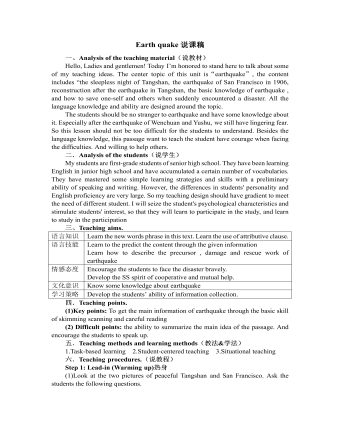
人教版高中英语必修1Earth quake说课稿
(4)Finally, I will ask the SS what this sentence mean:It is always calm before a storm.Purpose: attract the SS attention and bring them into discussionStep 2: Pre-reading 读前Here, I will do the second question in pre-reading first. I will use the method of brainstorming to ask the SS what will happen before an earthquake; and list the phenomenon on the table. 2. Then I will show the SS the picture of abnormal phenomenon, at the same time, encourage the SS to describe.3、finally, I will summarize these phenomenon4、Do the first question in the pre-reading , Imaging your home begins to shake and you must leave it right away. You have time to take only one thing. What will you take? Why?Purpose: help the SS to get further understanding of the topic and stimulate their interests.Step3: While-reading 阅读(1). Skimming Read the text quickly and catch the meaning of the first and second sentence of each paragraph. Predict the meaning of new words(2).scanning(找读)A. Read the text again. Do the following question.1. When and where were the strange things happening?2. What are they?3. Why did the text say the world seemed to be at an end?4. How was the city destroyed after the quake?5. When did the second quake hit the city? What was the result of that?6. Who came to help Tangshan first? And how?B. Work in pairs to discuss the question.
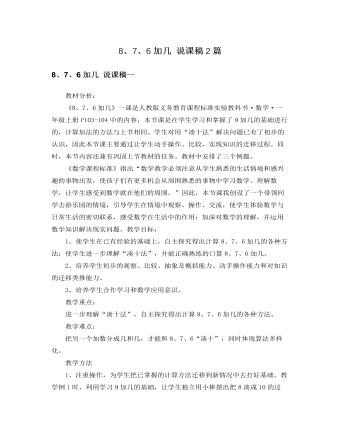
人教版新课标小学数学一年级上册8、7、6加几 说课稿2篇
《8、7、6加几》一课是人教版义务教育课程标准实验教科书·数学·一年级上册P103-104中的内容,本节课是在学生学习和掌握了9加几的基础进行的,计算加法的方法与上节相同。学生对用“凑十法”解决问题已有了初步的认识,因此本节课主要通过让学生动手操作、比较,实现知识的迁移过程。同时,本节内容还兼有巩固上节教材的任务。教材中安排了三个例题。《数学课程标准》指出“数学教学必须注意从学生熟悉的生活情境和感兴趣的事物出发,使孩子们有更多机会从周围熟悉的事物中学习数学、理解数学,让学生感受到数学就在他们的周围。”因此,本节课我创设了一个带领同学去游乐园的情境,引导学生在情境中观察、操作、交流,使学生体验数学与日常生活的密切联系,感受数学在生活中的作用;加深对数学的理解,并运用数学知识解决现实问题。
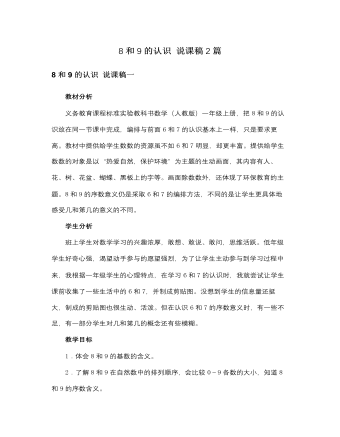
人教版新课标小学数学一年级上册8和9的认识 说课稿2篇
教材分析义务教育课程标准实验教科书数学(人教版)一年级上册,把8和9的认识放在同一节课中完成,编排与前面6和7的认识基本上一样,只是要求更高。教材中提供给学生数数的资源虽不如6和7明显,却更丰富。提供给学生数数的对象是以“热爱自然,保护环境”为主题的生动画面,其内容有人、花、树、花盆、蝴蝶、黑板上的字等。画面除数数外,还体现了环保教育的主题。8和9的序数意义仍是采取6和7的编排方法,不同的是让学生更具体地感受几和第几的意义的不同。学生分析班上学生对数学学习的兴趣浓厚,敢想、敢说、敢问,思维活跃。低年级学生好奇心强,渴望动手参与的愿望强烈,为了让学生主动参与到学习过程中来,我根据一年级学生的心理特点,在学习6和7的认识时,我就尝试让学生课前收集了一些生活中的6和7,并制成剪贴图。没想到学生的信息量还挺大,制成的剪贴图也很生动、活泼。但在认识6和7的序数意义时,有一些不足,有一部分学生对几和第几的概念还有些模糊。

人教版高中英语必修4Body Language说课稿4篇
Textbook: Senior English for China (Book 4), by Liu Daoyi Time Allotment: 1 period (40 minutes)Date: March 20, 2014Teaching aids: blackboard, Multi-media, Power Point, chalk I. Text Analysis (教材分析)This unit is about body language, and the text selected in the reading part demonstrates the difference and similarity of body language in many parts of the world. Through learning this passage, students are required to raise their awareness of using body language in different parts of the world. As body language is closely related to our daily life, it is easy to arouse students’ interest in learning this text. Reading skills and speaking training are designed around the text.II. Teaching Objectives (教学目标)By the end of the lesson, students will be able to:1. Language Skill Objective(语言技能目标): develop reading ability (skimming and scanning)as well as speaking ability.2. Cultural Knowledge Objective(文化知识目标): know about the cultural differences of using body language.3. Affective Objective(情感目标): increase students’ awareness of using body language correctly in different cultures. III.Teaching Focuses and Difficulties(教学重点和难点)1. Teaching Focuses(教学重点): the difference and similarity of body language in many parts of the world.2. Teaching Difficulties(教学难点): develop students’ reading abilities of skimming and scanning and ask the students to show their opinions with fluent English.

人教版高中英语必修2Computers说课稿3篇
一. 教材分析1. 本单元的中心话题是“计算机(Computers)”,内容涉及计算机的发展历史,计算机的应用等。本节课是该单元的第一课时,我将Warming up, Pre-reading and Comprehending这四部分整合为一节精读课。其中。Reading部分是题为WHO AM I?的文章,以第一人称的拟人手法介绍了计算机发长演变的历史和计算机在各个领域的应用,其主旨是表达计算机的发展变化之快以及在生活中用途之广。而Warming up部分以图片的形式展现了计算机的发展历程;Pre-reading中的问题和排序分别是为了预测语篇的内容和测试学生对计算机历史了解的情况;Comprehending则通过各项练习训练学生的阅读技能,从而加深对文章的理解。可见这几部分是一个有机的整体。2. 教学目标:1) 语言目标:重点词汇及短语:abacus, calculate, calculator, PC, laptop, PDA, robot, analytical, technological, universal, mathematical, artificial, intelligent, network, explore, in common, as a result.重点句子:a. My real father was Alan Turing, who in 1963 wrote a book to describe how computers could be made to work, and build a “universal machine” to solve any mathematical problem.

人教版高中英语必修2Cultural Relics说课稿2篇
Ⅲ. Analysis of the teaching material:The topic of this unit is cultural relics. Students are quite interested in topics about different cultures around the world. This is the second period of the whole unit. As a reading class, the passage mainly talks about the history of the amber room (how it was made, sent as a gift, lost and rebuilt).According to the new national curriculum, when teaching reading, much emphasis should be put on training the students’ reading skills.Ⅳ. Teaching objectives1. Language objectives:1) Students are required to master the key words and phrases occurred in the passage (e.g. amazing, decorate, belong, in return, less than etc.)2) Students are required to learn the attributive clause and acquire the sentence pattern.2. 1) Students are required to describe a certain thing by using the new sentence patterns.2) Students are required to master two kinds of reading skills—skimming and scanning, and learn to use them in their daily reading.3. 1) Students are required to know the history of the amber room.2) Students are required to appreciate cultural relics and understand the importance of protecting them.Ⅴ. Teaching important and difficult points1) the new words, phrases, and sentence pattern in the course of reading.2) Teaching difficult point: Help the students master two kinds of reading skills—skimmingand scanning and learn to apply them in daily use.Ⅵ. Teaching methods:Task-based method & Top-down model Ⅶ. Teaching aids: PPT, pictures, blackboard Ⅷ. Teaching procedure:

人教版高中英语必修2Wildlife Protection说课稿3篇
When it comes to the students’ studying methods, I'd like to introduce my Ss first. The Ss have a good command of basic language points. They’re interested in learning English, and they take an active part in English class, so they will have fun in autonomous, cooperative and inquiry learning. I will just serve as a guide, showing them the way to explore how to make more progress in their English learning.Now it’s time for the most important stage of this lesson. My teaching procedures are arranged as follows:Step1.Leading-in (3 minute)Play a video of a wide variety of wildlife to introduce my topic. Step2. Speaking (12 minutes)We will use our textbook Page25. Let the Ss fast read the short paragraph to warm up. Ask them to talk about the report on some endangered wildlife in China with the dialogue patterns on the screen. Lastly, I will invite some groups to demonstrate their dialogues about saving wildlife in China.Step3.English play (3 minutes)Watch another video in praise of their excellent performance just now. It’s about Jack Chen’s(成龙)and Yang Ziqiong’s wildlife protection.Step4. Listening (twice 13 minutes)This time, I’ll ask the Ss to fill in the blanks of the monologue of the 2 movie stars above. Step5.Discussion (3 minutes)Which would you like to choose to wear, clothes made of cotton, artificial leather or animal skins? Why ?Step6. Summary (3 minutes)1. If there were no wildlife, there wouldn’t exist human beings. If the buying stops, the killing can, too.2. Animals are our friends. To love animals is to love ourselves. Stop hunting, killing and destroying wildlife.3. Let’s live in harmony with all the living things in the world. Step7. Music appreciation (3 minutes)Let the Ss appreciate the song Earth Song by Michael Jackson. Last but not the least, I will show you my blackboard design.

人教版高中英语必修4A taste of English Humor说课稿3篇
Then I would ask them to think of a funny English or Chinese and tell it to partners. While telling stories, they can use expressions and some acting to help make the story funny. 5 minutes would be given to do this.Those stories they told there will be the material for their writing. Soletting them tell it at first is helpful. And they can make a difference between telling a funny story and writing it down. Generally speaking, it is difficult forstudents to write well because they don’t know what to write and how to write. Asking them to tell their own stories at first can help them come up with what to write.After their telling, I would invite someone to share his/her story with all of us and I would write it down on the blackboard.This example story would be used as a sample to illustrate the format of funny story. Different from a story from teacher or textbook, a story from students can obviously become a interesting material to draw students’ attention.Then I would ask the whole class to put this story into several parts. It might be a little bit difficult for them. So I would ask them to find out whether all the sentences are necessary. After delete some sentences, there are 6 sentences left behind. Then they can easily put them into three parts. After interaction with students, I would teach them the right terms for each part and conclude the format of funny story.This step is the key and difficult point in my lesson. So I mainly usetask-based teaching method in this part and the task for students was divided into several stages. With the separated difficult level, students can find there are usually three parts in writing. They can also learn to write without the unnecessary parts in the process of analyzing. And then I wouldn’t rush to tell them the right terms to them directly. Instead, I would ask them to name them by their own. A confused mind is better for acquiring knowledge.While-writing:Then I would give students 7 minutes to write down this story, without other requirements.With all the preparations in pre-writing, students’ difficulties were cleared. So it would be much easier for them to write down the story within 7 minutes. There are no other requirements because students’ first writing is actually a drafting. It would be revise and edit several times later. Writing, as a skill

人教版高中英语必修4Women of achievement说课稿4篇
Good morning, distinguished judges:It’s my honor to talk about my teaching ideas with you. Today my topic is Women of Achievement. My presentation consists of six parts: the analysis of teaching material and student, teaching aims, key and difficult points, teaching and studying method, teaching procedures and blackboard design.First, let’s focus on the analysis of teaching material. This lesson is from New Senior English for China Student’s Book 4 Unit 1, the reading part. The main topic of the passage is the introduction of a student of Africanwildlife. After this lesson, the students will learn more information about her studying chimps in Africa, and their reading and speaking abilities can be developed as well.The next part is the analysis of students. My students are in senior high students. They have learnt English for many years, they’ve known many words and sentences, but their speaking and reading abilities are still not very good. So I will practice their speaking and reading abilities through different exercises.According to the New Standard Curriculum and the present situation, I set the teaching aims as follows: firstly, knowledge aims. Students can grasp some new words, such as worthwhile, move off. Moreover, students can understand the content of the passage and get familiar with the topic of studying chimps in wildlife. Secondly, ability aims. Students can use reading strategies such as skimming and scanning in reading process. Thirdly, emotional aims. Students can have the awareness of protecting animals and care about animals.Based on the above analysis, the key point of this lesson is to get the main idea and the detailed information from the passage; the difficult point is to talk about the wildlife protection and use reading strategies.

人教版高中英语必修4Theme parks说课稿3篇
The oldest and the most popular park in the worldenjoy the exciting activities thereget close to the life-size cartoon characters like Mickey Mouse and Donald Duck Step 3 Pre-reading1.What do you suppose a theme park is ?2.What do you think you can see in a theme park?(1.It is a kind of amusement park which has a certain theme – that the whole park is based on. 2.buildings, castles, statues, rare animals and birds, and so on.) Step 4 Reading ----- Theme Parks –---- Fun and More Than Fun1.Predict : Read the title and the pictures on P. 34 and PredictWhat is the meaning of the title “Theme Park – Fun and more than fun”?(The title means that theme parks are fun to visit, but that they can also be educational and can offer useful information.)2.Skimming Fast read and answer:What activities can we take in a theme park?Amusement park: Bumper car Merry-go-round slide bungee jumping Free-fall rides Horror films Pirate ship Ferris wheel roller coaster3.Scanning Read again and you will find various theme parks are mentioned in the passage . Then what are they ?Theme parks: Sports theme park History theme park Culture theme park Marine or Ocean theme Park Future park Science theme park Disneyland4.Careful reading and find the main idea of each paragraph:THEME PARKS---- entertaining/ educationalPara.1 Traditional parks are places to go for relaxation and to have time away from our busy lives.Para.2 Theme parks are different They’re large and full of things to do, see and buy.Para.3 Theme parks are built around a single idea or theme. One example is a sports park.Para.4 Another kind of theme park is historical more and cultural and can be educational.Para.5 Disneylandwas the first theme park. It is based on the fantasy life and characters of Disney’s films.Para.6 Some examples of educational theme parks include sea world parks and science parks.

人教版高中英语必修3Healthy Eating说课稿4篇
Language learning needs a context, which can help the learners to understand the language and then can product comprehensible output, so computer has the advantages to make the materials attractive.Part 3 Learning MethodsTask-based, self-dependent and cooperative learningPart 4 Teaching ProcedureStep One Lead-in“Interest is the best teacher.” Therefore, at the very beginning of the class, I should spark the students’ mind to focus on the centre topic “the band”. I’ll show some pictures of food to attract their attention and then bring some questions.Question:What kind of food they like?What should go into a good meal?The answers must relate to the diet. After this, the students will be eager to know something about a balance diet and this is the very time to naturally lead the class into Step 2Step 2 Reading for information: skimming and scanning In this step, I use Task-based Language Teaching method, which can give students a clear and specific purpose while skimming and scanning the context.Task 1 General ideaThe students will be asked to just glance at the title and the pictures of the passage, and then guess what they will read in the text. And they’ll be divided into groups of four to have a discussion.The purpose is to inspire the students to read actively, not passively. In addition, the task is to develop the students’ reading skill by making prediction and to encourage the students to express their thoughts in English and cooperate with each other.Task 2 Main idea of each paragraphCooperative learning can raise the students’ interest and create an atmosphere of achievement. Based on this theory, I divide the whole class into 4 groups to skim the whole text and get the main idea of each paragraph.

人教版高中英语必修5First aid说课稿6篇
In this class, I have 3 teaching aims, that is, knowledge aims, ability aims and emotion aims.1) Knowledge-Teach students new words and expressions, such as temporary, bleed,sprain choke, first aid, fall ill and so on.-Enable students to have a better understanding for some basic knowledge of first aid.2) Ability-Train students’ speaking, reading and writing abilities by different teaching activities, such as skimming, comprehending, team work, role play, retelling and writing.-Develop students’ reading strategy on how to move general idea to specific information.3) Emotion-Promote students’ awareness of giving first aid.- Cultivate students’ creativities.Then let’s come to my teaching methods and activities.III. Teaching methods and activities:To achieve different teaching aims, various kinds of teaching methods and activities will be adopted throughout this period, such as TBL (task-based learning), skimming, team work, brainstorm and others, which can offer students opportunities to fulfill tasks in which they can use language to achieve a specific outcome.IV. Teaching aids:Computer and blackboardV. Teaching important points:1) Make students have a clear mind for the structure of the text.2) Help students understand the theme of the text.VI. Teaching difficulties:1) So many new words may affect students’ understanding.2) How to get students to know about the functions of the skin and thecauses, characteristics and treatments for different degree burns,and the knowledge about giving first aid. VII. Blackboard design:

人教版高中英语必修5Great scientists说课稿4篇
通过写文章梗概,培养学生综合运用语言的能力,学习用恰当的英语描述科学家的故事。这是本课的教学难点。教师可以使用完形填空的方式来帮助学生整理语篇,从而来降低难度。本课的教学重点的突破方法是:在阅读前,让学生初步了解得出科学观点所需要的基本程序,从而轻松而自然地导入文章的阅读;在阅读过程中,由易到难设计快速阅读和精读的问题,层层推进各种阅读活动,让学生对阅读内容从整体感知到细节理解,最后深层读懂整篇文章,同时加强阅读策略的指导,让每个学生都主动参与课堂教学活动,最终达到提高阅读能力的目的。Step 4 Post-readingGroup Activities四人小组共同合作,在老师的适当指导下,就以下2个问题展开讨论,让学生就所知、所学、所感和所想融入话题,然后抽若干同学代表作小组发言。1. What do you think about John Snow, and what should we learn from him?2. Cholera was 19th century disease, which two diseases are similar to cholera today? Why?

人教版新课标小学数学一年级上册几和几 说课稿
(一)教学内容:教科书数学一年级上册第19-20的内容及练习二的第8-10题。(二)教材所处地位及作用:“几和几”数的组成知识是学习加减法的基础,这是一年级教学要注意的部分。在认数教学中,主要通过实物演示和动手操作的游戏,使学生知道了数的组成。(三)教学目标、重点、难点:教学目标:(1)使学生通过动手操作掌握5以内数的组成。(2)使学生能熟练地说出5以内数的级成,培养学生的观察、操作、表达能力,初步的自学能力。(3)培养学生认真做练习的良好习惯,积极动脑思考的学习品质及互助,创新意识和评价意识。教学重点:让学生通过动手操作掌握5以内数的组成教学难点:引导学生通过动手操作并掌握5以内数的组成。二、说教法本课时教学方法主要体现以下几点:1、创设游戏充分感知,然后再交流,使学生在主动参与知识的形成过程中体验到成功的快乐。最后,为学生创设了“分小棒”等游戏,让学生不断地动手操作与合作讨论中自己掌握知识,并初步培养学生的自学能力。
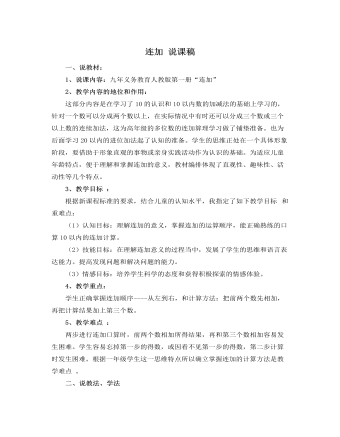
人教版新课标小学数学一年级上册连加 说课稿
[设计意图:心理学研究表明低年级学生注意力集中时间较短,兴趣容易转移,针对这一特点,出示学生情有独钟的小动物,增加情趣性,充分激发学生的兴趣,形成探究的欲望。这种疑惑,正蕴含着不解、猜度以及思维的发动;这惊奇,则蕴含着求索、发现以及对思维的刺激。至于哪种积极的探究欲望,可使学生获得想象力和猜度的乐趣,维系发现和创造的信心。通过讲讲练练,既抓住了重点,又突破了难点。]4、回忆总结,系统建构请学生回答做连加时该提醒小朋友注意什么?最后师生共同小结。[设计意图:培养了学生口头表达能力,便于教师及时掌握情况,收取反馈信息,加深理解。促进学生的思维由具体形象逐步向抽象的逻辑思维过渡。](三)巩固强化,拓展思维1、基本题:(1)集体练习,摆一摆再填数,通过操作学具,巩固连加知识。(2)看图列连加算式计算。
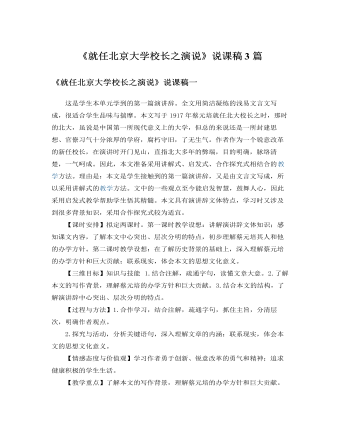
人教版高中语文必修2《就任北京大学校长之演说》说课稿3篇
(三)教学重、难点1、教学重点:结合课文,了解演讲辞针对性强、条理清楚、通俗易懂、适当的感情色彩等特点。2、教学难点:深入理解文章内涵,联系现实,体会本文的现实意义二、说学情高中学生在初中阶段已经接触过演讲辞了,对演讲词的特点已经有了一些基本的知识,因此本轮的教学应该让他们在此基础上有所提高。本文是学生在高中阶段第一次接触演讲辞,有必要让他们了解演讲辞的特点及课文如何体现这些特点的。随着年龄的增长,生活阅历的增加,高中学生正逐渐形成自己对世界、对人生的看法,蔡元培先生的这篇文章能很好地激发他们对当前的高中学习和未来的大学生活进行思考。此外,学生对北大的历史及蔡元培先生作这番演讲的时代背景了解不深,应作出补充说明。

人教版新课标小学数学一年级下册摆一摆,想一想 说课稿3篇
2,解决三个圆片能摆出的数。小精灵聪聪也给大家提问题了:(课件出示:你能用三个圆片表示不同的数吗?)你们回答他,能不能?(1)现在请小朋友们自己动手摆一摆,并且不自己摆出来的数写在老师发给你们的纸上,看谁摆的又快又对。(2)汇报结果:你摆了几个数?分别是什么?是怎么摆的 ?这个活动的设计是为了培养学生的动手操作能力,提高学生学习数学的热情。利用自己总结出来的方法来进行操作,让学生体会到成就感。通过学生的汇报,培养学生的语言表达能力,让学生的手,脑,口的能力同时得到了锻炼。3,小朋友们真棒,现在我们不摆圆片,你能不能在脑子里想着摆圆片的方法,在纸上写出四个圆片都能表示那些数字呢 ?这个活动的设计,是让学生从操作走向有序的思维,让学生有条理的思考问题,将数学抽象化。
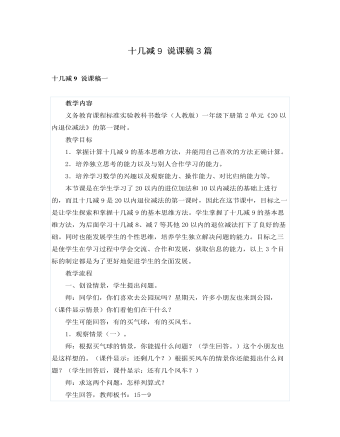
人教版新课标小学数学一年级下册十几减9 说课稿3篇
2.通过动手操作、交流算法,使学生经历十几减9的过程,知道想加算减、破十法、连减等多种计算方法,理解算理,掌握算法。能正确计算。3.在学习过程中,培养学生简单的推理能力、表达能力和解决问题的能力。教学重点:掌握十几减九的计算方法,正确、熟练的进行计算。教学难点:经历十几减九的过程,感受算法多样化,理解算理。我的教学过程分为四个大环节,其中第二环节是本节课的重点环节,我又设计了五个小层次:下面我就具体说一说我的教学过程。一、创设情境,复习导入(3分钟)我以元旦快到了,班里要举行游艺活动这样的情境进入练习。【设计意图:在带着学生走向新知之前,再现与新知有关的原认知,复习前面所学的20以内的进位加,数的分解和组成及10减几等知识,为今天学习新课做好铺垫。】接着我以元旦游艺活动,班里要用气球布置教室来引入新课。【设计意图:以学生感兴趣的身边问题吸引他们的注意力,激发兴趣,并巧妙引出新课。】
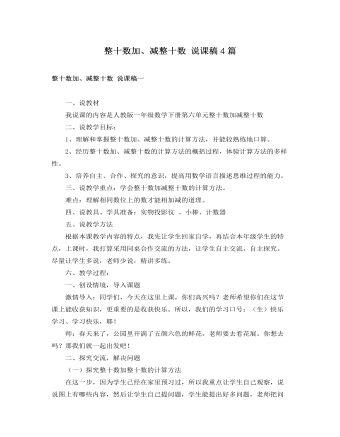
人教版新课标小学数学一年级下册整十数加、减整十数 说课稿4篇
2、教材分析整十数加、减整十数的计算是在10以内加、减法的基础上进行的,只是计数单位不同,这里以十为计数单位。教学内容的编排,分三个层次:一、以实际情景——花卉展提供计算题,并呈现算法的多样化;二、让学生动手操作(如摆小棒)理解算理、掌握算法;三、脱离直观手段,让学生思考算法。通过让学生在生动具体的情境中学习计算,引导学生独立思考与合作交流多种不同的算法,进一步培养计算能力。这样安排,有助于学生加深对相同单位的数可以直接相加、减的认识,为后面学习任意两个数相加、减打基础。整十数加、减整十数属于计算教学中的重点内容之一,应给予足够的重视。教材的编排是由直观操作等依靠实物思考到脱离实物思考,遵循由具体到抽象的原则,有利于学生抽象思维的培养,为进一步提高计算速度、培养计算能力,解决实际问题打基础。
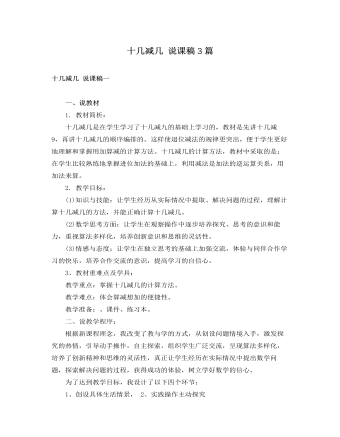
人教版新课标小学数学一年级下册十几减几 说课稿3篇
得到13-8=这个算式后,我让小朋友们想办法,“13-8怎么算?你是怎样想的?把你的想法告诉你小组的同学们。”由于我是用讲故事的形式引出这一问题的,因此在计算13-8时,小朋友们就被迫要自己想办法去计算,而不能光借助情境图去直接数出得数。这并不阻碍算法的多样化,相反更好地实现了算法多样化的目的,真正让学生成为了数学学习的主人。为了增加这堂课的趣味性,我有意将学生说出来的各种算法分别以他们的名字来命名,这样一来,学生兴趣盎然,都积极投入到了寻找算法的思考活动中来了。在寻求多样化的过程中,充分发挥了学生学习的主体性,培养了学生的创新精神,让每一个学生都能体验学习的成功。学生们在思考、讨论中可能会出现这样几种算法:

